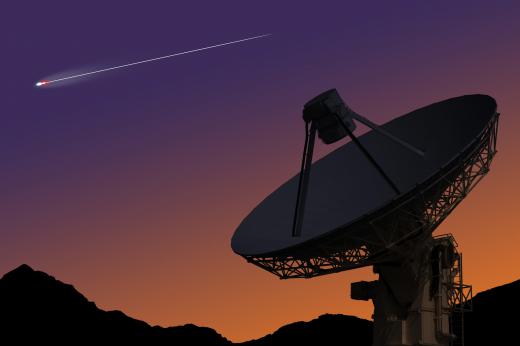What is a Radio Telescope?
 Mary McMahon
Mary McMahon
A radio telescope is a telescope which is used to collect data from the radio range of the electromagnetic spectrum. A number of astronomical observations can be made with radio telescopes, making the data they collect very valuable. Some notable examples of radio telescopes include the big dish telescope at Arecibo in Puerto Rico, and the telescopes used at the National Radio Astronomy Observatory (NRAO) in Green Bank, Virginia.
When people look up at the night sky and see the light of distant stars, they are actually only seeing a very small part of a much bigger picture. Stars and other astronomical objects emit waves in a variety of areas of the electromagnetic spectrum. Although these emissions cannot be seen because they do not occur in the visual spectrum, they can be picked up with radio telescopes and other very delicate detection devices, all of which are designed to collect and amplify the information so that it can be studied.

The big problem faced by a radio telescope is that the Earth's atmosphere interferes significantly with radio waves emitted by distant objects, making them very weak by the time they reach the Earth. Radio telescopes are either very large or comprised of an array of linked telescopes to compensate for this problem. They act as giant antennas to pick up even the weakest of signals, and they are classically located in remote areas to reduce interference from other sources of radiation so that the signals can come through more clearly to the radio telescope.

Non-scientists actually pick up radio signals from the universe all the time, even though they don't realize it. The static which fills the radio when it's not tuned in to a specific station contains radiation from a wide number of sources of Earth, along with a very small fraction of radiation from space; one is actually tuning in to the Big Bang, in a sense, while listening to static. The radio telescope is designed to amplify the signals produced by objects such as quarks, planets, and stars so that astronomers can study them, with different designs honing on on different areas of the radio spectrum to make different types of observations.

With the assistance of radio telescopes, astronomers can learn more about the nature of the universe and the origins of the universe. The radio telescope has contributed significantly to the development of theories about how the Big Bang occurred and how objects are formed and destroyed in the universe. They also provide information about distant and close neighbors alike, although as yet, scientists haven't picked up any signs of radio transmissions which are deliberately created from any planet other than Earth.
AS FEATURED ON:
AS FEATURED ON:













Discussion Comments
What ever came of the repeating signal picked up by Stanford radio astronomers in 1968? According to Arthur C. Clarke, it repeated between 3 a.m. and 6 a.m. every 1,337 seconds, and transmitted between Vega and Altair.
Post your comments